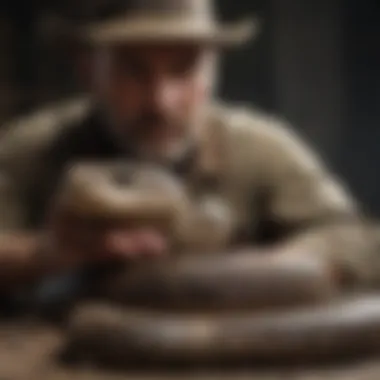Practical Methods for Safely Removing Snakes from Your Home Environment


Preventive Pest Control Strategies
When it comes to effectively managing snakes around your home, implementing preventive pest control strategies is crucial. Starting with the house exterior, sealing cracks not only keeps out pests like snakes but also enhances the overall integrity of your home. Clearing debris from your yard is another essential step as it eliminates potential hiding spots for snakes. Preventing pests from entering your home can be achieved by investing in proper screening on doors and windows. Moving to yard maintenance, keeping your yard well-groomed and free of clutter can deter snakes from making their home on your property. Implementing methods such as regular mowing, trimming shrubs, and removing excess vegetation can significantly reduce the chances of snakes inhabiting your yard.
Maintaining indoor cleanliness is equally vital. Expert cleaning tips including proper storage of food and waste disposal can discourage snake activity indoors. By creating a pest-resistant indoor environment through regular cleaning routines, you can minimize the risk of snake encounters. Efficient garbage disposal is a key aspect of pest prevention. Proper waste management not only keeps your surroundings clean but also eliminates food sources that might attract snakes. Other pest prevention strategies like installing secure fencing and using natural repellents can further safeguard your home against unwanted snake visitors.
Understanding Snake Behavior
Understanding snake behavior is crucial in effectively dealing with snake encounters around your home. By comprehending the behavior patterns of snakes, individuals can implement proactive measures to prevent unwanted interactions. This section delves into the types of snakes commonly found around homes and the reasons why they are attracted to residential areas.
Types of Snakes Commonly Found Around Homes
Identifying Non-Venomous Snakes
Identifying non-venomous snakes plays a significant role in snake management. Knowing how to differentiate non-venomous species from venomous ones helps homeowners make informed decisions when encountering snakes. Characteristics such as round pupils, a single row of scales on the underside, and a lack of heat-sensing pits are key features for identifying non-venomous snakes. This knowledge is invaluable in ensuring the safe removal of snakes without causing harm.
Recognizing Venomous Species
Recognizing venomous species is essential for prioritizing safety when dealing with snakes. Venomous snakes possess distinct features such as triangular heads, vertical pupils, and heat-sensing pits. Understanding these characteristics aids in taking appropriate precautions and seeking professional help if venomous species are identified. While venomous snakes pose a higher risk, being able to recognize them increases preparedness and reduces the likelihood of dangerous encounters.
Reasons Snakes Are Attracted to Residential Areas


Search for Food Sources
Snakes are often drawn to residential areas in search of abundant food sources. Rodents, insects, and small animals that thrive in human environments serve as prey for snakes. By targeting these food sources, snakes find ample sustenance in yards and gardens, increasing the likelihood of their presence. Implementing measures to reduce accessible food can deter snakes from frequenting residential spaces.
Seeking Shelter and Ideal Habitat
Apart from food sources, snakes are attracted to residential areas due to the availability of shelter and suitable habitats. Areas with dense vegetation, piles of debris, and unsealed structures provide hiding spots and ideal environments for snakes to thrive. By understanding snakes' preference for sheltered locations, homeowners can modify their surroundings to make them less attractive to these reptiles. Creating unfavorable conditions for snakes can help in controlling their presence around homes.
Preventive Measures to Discourage Snakes
Maintaining a Tidy Yard and Garden
Regular Lawn Maintenance
Regular lawn maintenance is a fundamental aspect of snake prevention. By keeping your lawn consistently trimmed and well-kept, you eliminate potential hiding spots and refuge for snakes. The key characteristic of regular lawn maintenance lies in its ability to reduce clutter and overgrowth, which are attractive to snakes seeking shelter. This practice is highly beneficial for this article as it emphasizes creating an environment that is less appealing to snakes, thus decreasing the likelihood of snake encounters. The unique feature of regular lawn maintenance is its simplicity yet effectiveness in deterring snakes, making it a popular choice for homeowners concerned about snake presence.
Proper Trash Disposal
Proper trash disposal plays a significant role in snake prevention by removing attractants such as food sources and shelter. By securely sealing trash cans and promptly disposing of garbage, you minimize the chances of attracting snakes to your property. The key characteristic of proper trash disposal is its ability to eliminate odors and debris that might lure snakes. This method is a beneficial choice for this article as it addresses one of the primary reasons snakes are drawn to residential areas. The unique feature of proper trash disposal lies in its direct impact on reducing snake activity around homes, underscoring its advantages in maintaining a snake-free environment.
Sealing Entry Points to Your Home


Checking for Gaps and Cracks
Checking for gaps and cracks in your home's foundations, walls, and windows is essential for preventing snake intrusion. By identifying and sealing these openings, you create a barrier that limits snakes' access to indoor spaces. The key characteristic of checking for gaps and cracks is its role in closing off potential entry points for snakes, thereby fortifying your home against unwanted reptilian guests. This practice is a popular choice for this article as it addresses a critical aspect of snake prevention with tangible results. The unique feature of checking for gaps and cracks is its cost-effective nature and long-term efficacy in preventing snake incursions, highlighting its advantages for homeowners concerned about snake control.
Installing Tight-Fitting Screens
Installing tight-fitting screens on doors, windows, and vents adds an extra layer of protection against snake entry. These screens act as physical barriers that prevent snakes from slithering into your home through small openings. The key characteristic of tight-fitting screens is their ability to block off potential access points for snakes while allowing ventilation and natural light to permeate the house. This method is a beneficial choice for this article as it enhances existing defenses against snakes and reinforces the importance of securing entryways. The unique feature of installing tight-fitting screens is the peace of mind it provides to homeowners, knowing that their living spaces are securely shielded from snake intrusion with minimal restrictions on air circulation.
Humane Methods of Snake Removal
Humane methods of snake removal play a crucial role in this article by emphasizing the importance of safely and ethically eliminating snakes from residential areas without causing harm. By incorporating humane practices, individuals can effectively manage snake encounters around their homes while prioritizing the well-being of these reptiles. The focus on humane methods ensures that the removal process is carried out with compassion and without causing unnecessary distress to the snakes. This approach aligns with the ethical considerations of coexisting with wildlife and safeguarding biodiversity.
Utilizing Natural Repellents
Natural Oils and Scents
Natural oils and scents are essential components in deterring snakes from residential spaces. These substances, such as clove oil, cinnamon, and peppermint, emit strong odors that snakes find unpleasant, effectively repelling them from the area. The key characteristic of natural oils and scents lies in their non-toxic nature, making them a safe and environmentally friendly choice for snake removal. Their unique feature of acting as natural deterrents without causing harm to the snakes or the environment makes them an ideal option for individuals looking to protect their homes from snake intrusions.
Plants That Deter Snakes
Certain plants possess properties that naturally deter snakes, serving as a preventive measure against snake infestations. Plants like marigolds, wormwood, and garlic emit odors or contain compounds that snakes dislike, effectively discouraging them from entering the vicinity. The key characteristic of these plants is their ability to repel snakes organically, offering a chemical-free and sustainable approach to snake control. The unique feature of using plants as snake deterrents is their dual function of adding aesthetic value to the landscape while serving as a natural barrier against these reptiles. Their advantage lies in providing a holistic and eco-friendly solution to snake management.


Implementing Physical Barriers
Snake Fencing
Snake fencing serves as a physical barrier that prevents snakes from entering designated areas, effectively reducing the risk of snake encounters around homes. The key characteristic of snake fencing is its durable and impenetrable design, specifically constructed to withstand snake attempts to infiltrate properties. Its unique feature lies in providing a long-term solution to snake control without posing any risks to the snakes or the environment. While it's beneficial in keeping snakes at bay, individuals should consider the installation and maintenance costs associated with snake fencing to weigh the advantages and disadvantages for their specific situation.
Snake Traps
Snake traps offer a non-lethal method of capturing snakes for later release into more suitable habitats. These traps are designed to safely confine snakes without harming them, allowing individuals to relocate them to remote areas away from residential spaces. The key characteristic of snake traps is their efficiency in capturing snakes without causing any injuries, making them a humane approach to snake removal. Their unique feature of enabling the controlled capture and release of snakes minimizes potential harm to both snakes and humans, aligning with ethical considerations in wildlife management. Individuals utilizing snake traps should be vigilant in regularly checking and emptying the traps to ensure the safe removal and relocation of captured snakes.
Seeking Professional Assistance
When dealing with snake infestations or encounters around your home, seeking professional assistance plays a pivotal role in effectively and safely managing the situation. Professional wildlife experts bring a wealth of knowledge and experience to the table, ensuring the proper handling and removal of snakes without endangering the environment or risking harm to the snakes themselves. By entrusting the task to these professionals, you can mitigate potential risks and ensure a smooth and humane resolution to snake-related issues.
Contacting Wildlife Experts
Licensed Wildlife Removal Services
Licensed wildlife removal services are a crucial component of effectively addressing snake problems around residential areas. These services are staffed with trained professionals who understand the behaviors and habits of different snake species, enabling them to implement tailored and targeted removal strategies. Licensed services possess the necessary expertise and equipment to handle snakes safely, minimizing risks to both humans and the snakes themselves. By engaging licensed wildlife removal services, homeowners can rest assured that the removal process will be carried out efficiently and with a focus on environmental preservation.
Local Animal Control Agencies
Local animal control agencies serve as another valuable resource when it comes to dealing with snake-related issues. These agencies are well-versed in handling various wildlife concerns, including snake encounters in residential settings. One key advantage of turning to local animal control agencies is their in-depth knowledge of the local ecosystem and wildlife regulations. They can provide insights into the appropriate protocols for dealing with snakes in a specific area, ensuring compliance with relevant laws and guidelines. Additionally, local animal control agencies often collaborate with wildlife experts, allowing for a multidisciplinary approach to snake removal that prioritizes both safety and environmental preservation.
Understanding Local Regulations
Permits and Permissions Necessary
Understanding the local regulations surrounding snake removal is essential for homeowners looking to address snake issues effectively. Permits and permissions are often required for certain removal methods or in cases involving protected snake species. By obtaining the necessary permits, homeowners can ensure that their actions are legally sound and aligned with conservation efforts. However, navigating the permit process can be complex, requiring a thorough understanding of local laws and regulations. While permits add an extra layer of complexity to snake removal, they also serve as a safeguard against unregulated practices that could harm snake populations or disrupt the ecosystem. By adhering to permit requirements, homeowners demonstrate their commitment to responsible and ethical snake removal practices.



